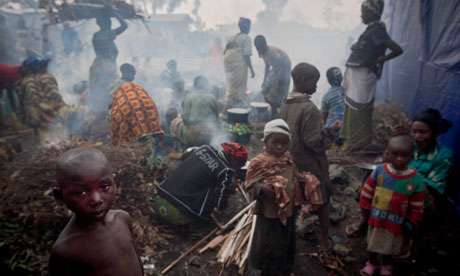undeterred
undeterred's JournalWars push number of internally displaced people to record levels
Crises in Syria and Democratic Republic of the Congo in 2012 help push total figure of people displaced worldwide to 28 millionMark Tran
guardian.co.uk, Monday 29 April 2013 04.00 EDT
Wars in Syria and the Democratic Republic of the Congo (DRC) pushed the number of people internally displaced by armed conflict, violence and human rights violations to 28.8 million last year, the highest figure recorded by the Internal Displacement Monitoring Centre (IDMC) in Geneva. More than 6.5 million people were newly displaced within their own countries in 2012, almost twice as many as the year before, IDMC said in its annual report. Since these people have not crossed borders, they are not refugees and do not benefit from international protection.
The situation in Syria is particularly critical, as it is the world's largest and fastest evolving crisis in terms of new displacements. The number of Syrian internally displaced persons (IDPs) is now more than 3 million, of which 2.4 million were displaced last year. "The crisis is in its third year and the escalation has gone beyond a tipping point," said Clare Spurrell, an IDMC spokeswoman. "Humanitarians can't save Syria, it has to be the politicians … what you are seeing are people who are utterly exhausted. The internally displaced are completely reliant on others, but host communities are themselves suffering from a lack of food, and diseases are breaking out." The UN high commissioner for refugees, António Guterres, has described the Syrian civil war as the worst humanitarian disaster since the end of the cold war, and more brutal and destructive than the conflicts in Iraq and Afghanistan. Until the conflict in Syria is resolved, internal displacement will continue to accelerate, said the IDMC, pointing out that this phenomenon has been seen in other countries with drawn-out conflicts.
Colombia has the largest number of IDPs in the world, followed by Syria and the DRC, which has the third largest IDP population. The region with the largest number of IDPs last year was sub-Saharan Africa, where there were 10.4 million IDPs by the end of 2012, almost a third of the world's internally displaced population. About a million people fled their homes in DRC as a result of attacks from the rebel group M23. In November, 140,000 people fled the North Kivu capital of Goma in a single week as M23 forces entered the city. Conflict in Mali and increased violence in Nigeria from the radical Islamist group Boko Haram also caused large new displacements.
The report suggests that while a resolution to the conflict, particularly in Syria, is critical to dealing with an internal displacement crisis, so too is bridging the gap between emergency response and development. "Ninety percent of the countries monitored by IDMC have IDPs living in protracted displacement, often for decades, while second and third generations are born into displacement,'' said Kate Halff, director of IDMC. She added: ''Governments are responsible for finding long-term solutions for their displaced citizens. However, they can only be realised when the governments and the international community recognise that people forced from their homes require not only a humanitarian response at the height of a crisis, but sustained engagement until a lasting solution is achieved."
more at http://www.guardian.co.uk/global-development/2013/apr/29/record-levels-internally-displaced-people

Families displaced by recent fighting between M23 rebels and Congolese government soldiers cook in the rain at Don Bosco Orphanage in Goma, Democratic Republic of the Congo, in November 2012. Photograph: Kate Holt/Oxfam
Combating Tech’s Conflict Minerals With Disclosure
APRIL 15, 2013, 12:05 AM By QUENTIN HARDY

Some of our most advanced technology products have helped finance the deadliest conflicts of our time. Perhaps, if tech companies change some of their habits, that can change. An essential part of most cellphones is the mineral tantalite, which is frequently obtained from the Democratic Republic of Congo under murky circumstances. Tin, tungsten and gold also finance armed groups in Congo on their way to our laptops and tablets. Hewlett-Packard announced on Monday that it is publishing a list of 195 ore smelters, located around the world, that are identified with the minerals inside the company’s products. Within about two years, the company says, it wants its parts suppliers, which buy from these smelters, to make sure its minerals were not obtained from conflict zones.
“We believe the upshot of this is, over time, to lower violence and repression,” said Tony Prophet, who runs the global supply chain for H.P.’s personal systems group. “The smelters are the chokepoint. Once you locate them, you can start to pressure them to set a standard.” While H.P. may be as much as four steps away from the smelters in the supply chain, Mr. Prophet said, as a major purchaser it can still compel good behavior.
In August, the Securities and Exchange Commission also adopted a rule requiring all publicly traded companies to disclose their use of certain conflict minerals beginning next year, although that rule is facing a court challenge. The issue illuminates a chaotic underside to the clean orderliness of high-tech products. Over the last 15 years, some nine nation’s armies, and perhaps 15 or more armed groups, have fought in Congo. The body count for the region’s wars is estimated to be over five million, making it the world’s deadliest conflict since World War II.
This coincides with the rise in popularity of mobile devices, which has increased demands for minerals found in Congo. That, in turn, attracts warlords. Despite all the killing, supplies have been stable. The minerals, it turns out, are aggregated through a series of middlemen, much the way illicit drugs are gathered from small-scale growers.
http://bits.blogs.nytimes.com/2013/04/15/combating-techs-conflict-minerals-with-disclosure/
Profile Information
Gender: Do not displayCurrent location: Wonderland
Member since: Wed May 4, 2005, 01:01 PM
Number of posts: 34,658